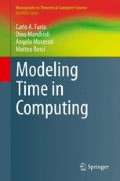Abstract
In this chapter, we recall, though well-known examples, the main concepts and definitions concerning dynamical systems. We introduce the classic notion of state-space representation of discrete-time and of continuous-time dynamical systems, and we discuss how one can move from the latter to the former. This chapter also briefly presents cellular automata, a family of discrete-time dynamical systems than can be used to model computations. Using the dimensions presented in Chap. 3 as reference, the chapter then describes the main features of the representation of time in dynamical systems.
Access this chapter
Tax calculation will be finalised at checkout
Purchases are for personal use only
Notes
- 1.
The attribute “dynamical” comes from the Greek word for “force” (\(\delta \upsilon \nu \alpha \mu \mathrm{o}\sigma \)), which is the source of system evolution in mechanical phenomena.
- 2.
For simplicity, we assume that the value of constant 1 ∕ (RC) does not impact the precision of the calculation.
References
Arnold, V.: Catastrophe Theory. Springer, Berlin (2004)
Benacerraf, P., Putnam, H. (eds.): Philosophy of Mathematics: Selected Readings. Cambridge University Press, Cambridge (1983)
Bittanti, S., Colaneri, P.: Periodic Systems: Filtering and Control. Springer, London (2009)
Boyer, C.B.: A History of Mathematics. Wiley, New York (1991). 2nd edn, revised by Uta C. Merzbach
Burden, R.L., Faires, J.D.: Numerical Analysis. Brooks Cole, Pacific Grove (2010)
Byrne, C.L.: Signal Processing: A Mathematical Approach. A. K. Peters, Wellesley (2005)
Chong, P.K.: The life and work of Leonardo of Pisa. Menemui Mat. 4(2), 60–66 (1982)
Chua, L.O., Desoer, C.A., Kuh, E.S.: Linear and Nonlinear Circuits. McGraw-Hill, New York (1987)
Cook, M.: Universality in elementary cellular automata. Complex Syst. 15, 1–40 (2004)
Ernest, P.: New angles on old rules. Times Higher Educational Supplement. http://people.exeter.ac.uk/PErnest/pome12/article2.htm (1996). Accessed 6 Sept 1996
Hamming, R.: Numerical Methods for Scientists and Engineers. Dover, New York (1987)
Hilborn, R.: Chaos and Nonlinear Dynamics. Oxford University Press, Oxford (2001)
Horadam, A.F.: Eight hundred years young. Aust. Math. Teach. 31, 123–134 (1975)
Khalil, H.: Nonlinear Systems, 2nd edn. Prentice-Hall, Upper Saddle River (1995)
Lathi, B.P.: Signal Processing and Linear Systems. Oxford University Press, Oxford (2000)
Leader, J.J.: Numerical Analysis and Scientific Computation. Addison-Wesley, Boston (2004)
Lind, D., Marcus, B.: An Introduction to Symbolic Dynamics and Coding. Cambridge University Press, Cambridge (1995)
Modelica and the Modelica Association. http://www.modelica.org
Moore, C.: Unpredictability and undecidability in dynamical systems. Phys. Rev. Lett. 64(20), 2354–2357 (1990)
Proakis, J.G., Manolakis, D.K.: Digital Signal Processing, 4th edn. Prentice Hall, Upper Saddle River (2006)
Schiff, J.L.: Cellular Automata: A Discrete View of the World. Wiley, Hoboken (2008)
Skogestad, S., Postlethwaite, I.: Multivariable Feedback Control: Analysis and Design, 2nd edn. Wiley, Chichester (2005)
Strogatz, S.H.: Nonlinear Dynamics and Chaos. Westview Press, Cambridge (2001)
von Neumann, J.: The general and logical theory of automata. In: Jeffress L.A. (ed.) Cerebral Mechanisms in Behavior—The Hixon Symposium, pp. 1–31. Wiley, New York (1951)
von Neumann, J.: The Theory of Self-reproducing Automata. University of Illinois, Urbana (1966)
Wolfram, S.: Cellular Automata and Complexity. Perseus Books Group, Oxford (1994)
Author information
Authors and Affiliations
Rights and permissions
Copyright information
© 2012 Springer-Verlag Berlin Heidelberg
About this chapter
Cite this chapter
Furia, C.A., Mandrioli, D., Morzenti, A., Rossi, M. (2012). Dynamical Systems. In: Modeling Time in Computing. Monographs in Theoretical Computer Science. An EATCS Series. Springer, Berlin, Heidelberg. https://doi.org/10.1007/978-3-642-32332-4_4
Download citation
DOI: https://doi.org/10.1007/978-3-642-32332-4_4
Published:
Publisher Name: Springer, Berlin, Heidelberg
Print ISBN: 978-3-642-32331-7
Online ISBN: 978-3-642-32332-4
eBook Packages: Computer ScienceComputer Science (R0)

